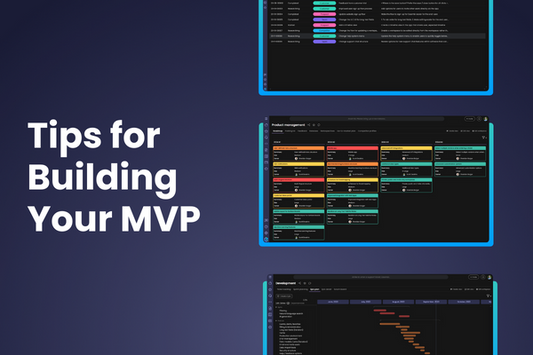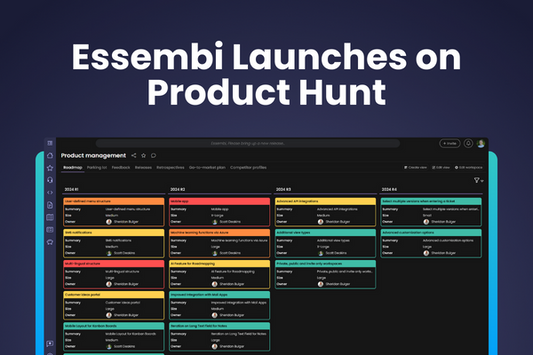Get in touch with Essembi.
-

-

Contact Sales
Contact SalesTouch base with a team member about using Essembi or expanding your current footprint.
Stay on the cutting edge of product management and AI news with Essembi's blog.
View All-

6 Ways to Get Promoted as a Product Manager
Looking to level up as a product manager? Here are 6 simple ways to ensure you get the recognition you deserve and position yourself for that promotion: 1. Tie new features to company strategy. Great product managers link key product roadmap initiatives to company strategy. This means understanding not only the immediate goals of the organization but also its long-term vision. Align each feature or product enhancement with how it contributes to the overarching objectives of the company. Consider the market positioning, target audience, and competitive landscape. By demonstrating a clear connection between your product roadmap and the broader organizational strategy, you gain credibility and support from stakeholders across the company. 2. Emphasize team communication. Every team within an organization believes they should dictate the product roadmap. Successful product managers get buy in from each team AND ensure each team feels like a "winner" when it comes to the product roadmap. The best way to do this is to communicate to other teams in your organization what you are doing and why you are doing it when it comes to the product roadmap. Do this by linking roadmap initiatives directly to company objectives and key results (OKRs). And don't just get buy in from the leader of each team, also get buy in from the "influencers" on teams. An influencer on a team is the individual or group that drives the sentiment of the team overall. As you make progress on your roadmap initiatives, circle back to teams to provide an update and reiterate the benefits it is bringing to the company and their individual team. 3. Understand the bottom line of the P&L. Jeff Bezos used to always tell his team "If you don’t understand the details of your business you are going to fail." One of the details that product managers need to learn is the business profit and loss statement (or the P&L). New features are not free to build or support. Many product managers focus on revenue or ARR ("annual recurring revenue") gains associated with a feature. The great product managers also understand the short- and long-term impact on the costs of building and supporting a new feature. As you build your product roadmap, make sure you understand and communicate the impact of these changes on the bottom line. This will help you earn the respect of the financial team and the trust of other business leaders. 4. Build simple, meaningful metrics. Track improvement over time. Business don't need more metrics today. They need simple metrics that actually track the health of the business. For example, growing businesses should not optimize around inbound support ticket volume. If the business is growing and users are engaged at a healthy rate, the volume should in fact be ticking up a bit. Optimize your business around metrics like customer satisfaction (CSAT), net promoter score (NPS) or net revenue retention as a factor of total revenue. After your establish what metrics are meaningful for your team, begin tracking improvement over time for each of these metrics. Hold your team accountable for incremental gains over time and help them understand how day-to-day action impact these metrics. 5. Spend time with actual users. Too many product managers hide behind decks, Figmas and their support team. Great product managers put down their mouse and get out to the front lines on occasion to better understand the needs of an actual user. Bill Gates always said: "Your most unhappy customers are your greatest source of learning." (Think he has been listening to recent feedback from Elon?) Check out how power users and regular users interact with your product and get answers from support. Watch their mouse clicks to learn how to make them more efficient. And interview them to understand what opportunities they see for product improvement or expansion to other teams at their company. Make this a recurring part of your product management organization and communicate your findings to all teams. 6. Embrace paradigm shifts. Product managers need to monitor and embrace paradigm shifts in multiple ways. The recent explosion in the AI market is the perfect example. AI exploded onto the market with OpenAI's ChatGPT being adopted by users at a record pace. Users and businesses were obsessed with the returns early on before a flood of relatively unexciting AI features deflated the experience and data security concerns arose. Product managers needed to be out in front of these two radical shifts - communicating internally an action plan and articulating a response to the customer base. The response does not need to be in the form of new features or releases. It could simply be a blog post explaining the game plan to get all stakeholders on the same page. Wrap Up Mastering these strategies will elevate your effectiveness as a product manager, increasing your chances of promotion and contributing to your organization's success. Dive in, implement these tactics, and watch your influence as a product leader grow.
6 Ways to Get Promoted as a Product Manager
Looking to level up as a product manager? Here are 6 simple ways to ensure you get the recognition you deserve and position yourself for that promotion: 1. Tie new...
-

From Idea to Traction: Building a Successful Minimum Viable Product as a Small Business
Learn how to turn your groundbreaking software idea into a successful venture with a Minimum Viable Product (MVP). Discover the strategic steps, from defining your target audience to measuring key performance indicators (KPIs), to effectively launch and iterate on your product.
From Idea to Traction: Building a Successful Minimum Viable Product as a Small Business
Learn how to turn your groundbreaking software idea into a successful venture with a Minimum Viable Product (MVP). Discover the strategic steps, from defining your target audience to measuring key...
-

Essembi Launches on Product Hunt
Table of Contents What is Product Hunt? Why Product Hunt? How will this impact Essembi's own product roadmap? Check out the Product Hunt launch listing... What is Product Hunt? Product Hunt is a terrific community of founders, product leaders, developers and tech junkies. It is a great place to discover new products and track new releases of existing products. Why Product Hunt? For a bootstrapped team racing to build new features and functions, Essembi is excited to get feedback from the Product community. How will this impact Essembi's own product roadmap? We prioritize all new incoming product feedback directly in - drumroll please - Essembi. Just as we encourage our customers to do, we document each incoming piece of product feedback as an "idea" in Esembi. Then, we prioritize each idea based on the user impact, maintainability of the product and ability for us to use that feature to sell the product. This helps us build the product roadmap. Our team cranks through development tasks on the product roadmap daily with new releases coming weekly. This speed helps us get new features in the hands of customers quickly. It is all part of the process of keeping our innovation cycle FAST. Check out the Product Hunt launch listing...
Essembi Launches on Product Hunt
Table of Contents What is Product Hunt? Why Product Hunt? How will this impact Essembi's own product roadmap? Check out the Product Hunt launch listing... What is Product Hunt? Product...
Free forever up to 5 users.
Perfect for start-ups, small teams or simply trying out Essembi.





